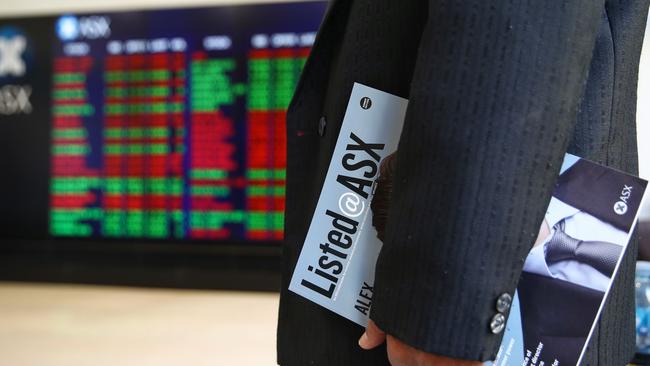Hold cash or take on volatility of the sharemarket?

For three successive years now, investors have been net sellers of US equities, yet share prices have continued to rally higher.
A recent in-depth analysis by UBS strategists Keith Parker and Sean Simonds estimates total selling in US stocks is close to the selling that occurred at the height of the global financial crisis 10 years ago.
To put some concrete numbers to that statement, on UBS’s calculations net selling since March 2017 had by December last year accumulated to $US690bn ($1.03 trillion), which is vastly larger than the $US475bn that occurred during the global downturn of 2015-2016 and the $US414bn that was withdrawn (net) during the GFC of 2007-2009.
To put that another way: calculated as percentages of the average market cap, net selling in 2017-19 amounts to -2.7 per cent, compared to -2.9 per cent during the GFC.
Another important observation made by the UBS strategists is that retail investors are mostly doing the selling.
Apparently, most of the money that flows out of equities moves into cash.
We don’t have any comparable data or analysis for Australian equities but it seems but a fair assumption that some of that cash has now found its way back into equities, both here and overseas.
Are we experiencing the ultimate capitulation that ensures this bull market has at least one more leg upwards left in it?
Realities of earning season
For those investors — professional or retail — who watch the market closely, there has been some telling action: the past few weeks have seen profit warnings from companies including Suncorp (SUN), Insurance Australia Group (IAG), QBE Insurance (QBE), AMA Group (AMA), NIB Holdings (NHF), Medibank Private, Nufarm (NUF) and Kogan (KGN).
At first glance, none of these warnings should have come as a major surprise. Bushfires and weather events lead to spikes in insurance claims. Extreme weather triggers changes in consumption, and affects tourism, outdoor sports and leisure, and the agricultural sector. Consumer spending is on the nose, and not just because of the bushfires. Analysts are already anticipating Qantas (QAN) will be next in providing guidance for fewer-than-anticipated international travellers, as well as Sydney Airport (SYD) in extension of the same theme.
Note also: the benign response to the share price of QBE Insurance post-warning possibly signals investors, in some cases, are willing to look beyond the immediate impact, at least for now.
In contrast, a handful of small caps have issued positive revisions to profit guidance: this small congregation of positive standouts thus far includes Polynovo (PNV), Bell Financial Group (BFG), EML Payments (EML), Data#3 (DTL) and K&S (KSC).
Earlier in the year investors did not wait for any market updates to assume that reduced geopolitical tension and an improving global outlook was working to the benefit of iron ore producers such as Fortescue Metals (FMG), Mount Gibson (MGX), BHP (BHP) and Rio Tinto (RIO).
But now the sudden emergence and spreading of the coronavirus from China has, temporarily at least, put a firm halt to that trend.
Looking beyond the events that have both stimulated and cooled down investor sentiment this January, the observation still stands that analysts’ forecasts for corporate profits are still declining, as they were throughout 2019, and this means the trend of rising valuations when corporate profits are not keeping pace has continued into the new year.
Lingering doubts
One of the lingering doubts among investors globally is that banks are making sizeable investments into new technologies, but contrary to other sectors, there doesn’t appear to be any tangible benefits coming from these investments. At least not in the short term. In Australia, banks might have seen the nadir in this down-cycle, but unless cash profits see a positive revival, they still won’t be a fantastic investment beyond the occasional bounce.
Meanwhile, the prospect for further dividend cuts from the more vulnerable in the sector continues, with Bank of Queensland (BOQ) widely considered as not done yet when it comes to negatively adjusting the payout to shareholders in line with operational pressures and the need for significant investments.
It is against this background that investors will soon be bombarded with ASX-listed companies releasing performance reports for the six months ending in December.
Given share prices tend to be high, even with a step-back from the all-time record because of coronavirus concerns, I’d suggest volatility is likely to spike yet again next month.
This season’s profit reports might be affected short term by the factors mentioned above. Certainly all investors — the professionals who stay in the market, and retail investors who had left and now look like they are coming back — will be keen to learn more about how the managers at the helm of companies see the future. Increasingly, this will include how companies are prepared for climate and weather-related events.
Rudi Filapek-Vandyck is editor of the investment website www.fnarena.com






One of the big mysteries behind the scenes of the current bull market in equities is the dramatic fall in investor participation, a fact I have highlighted on more than one occasion in recent years. The old adage was always that bull markets, in order to remain sustainable, required more buyers than sellers, but this market has thrown out the traditional blueprint, and then some.